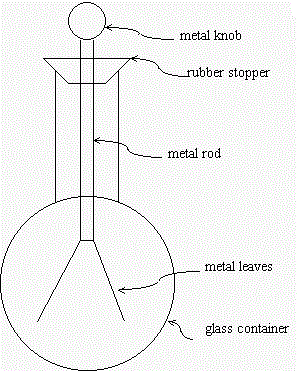NCERT Solutions for Chapter 15 Some Natural Phenomena 8 Science
Book Solutions1
Which of the following cannot be charged easily by friction?
(a) A plastic scale
(b) A copper rod
(c) An inflated balloon
(d) A woollen cloth
Answer
► (b) A copper rod
Exercises
Page Number 199
2
When a glass rod is rubbed with a piece of silk cloth the rod
(a) and the cloth both acquire positive charge.
(b) becomes positively charged while the cloth has a negative charge.
(c) and the cloth both acquire negative charge.
(d) becomes negatively charged while the cloth has a positive charge.
Answer
► (b) becomes positively charged while the cloth has a negative charge.
Exercises
Page Number 199
3
Write T against true and F against false in the following statements.
(a) Like charges attract each other. (T / F)
(b) A charged glass rod attracts a charged plastic straw. (T / F)
(c) Lightning conductor cannot protect a building from lightning. (T/F)
(d) Earthquakes can be predicted in advance. (T / F)
Answer
(a) False
(b) True
(c) False
(d) False
(b) True
(c) False
(d) False
Exercises
Page Number 199
4
Sometimes, a crackling sound is heard while taking off a sweater during winters. Explain.
Answer
Sweater is made of wool and generally shirt we wear is made of cotton blended with some synthetic fibers. Constant friction between the shirt and sweeter lets transfer of electrons from one material to the other. This results in building of electric potential. When enough potential has been accumulated, while taking of the sweater it discharges and transfer of electrons take place. Passage of electrons through air in the forms of spark let out heat and sound energy. Thus we hear the crackling sound and in dark rooms we may see the spark lights as well.
Exercises
Page Number 199
5
Explain why a charged body loses its charge if we touch it with our hand.
Answer
When we touch a charged body, with our hand, the excess of accumulated charge or static charges on it, gets transfer to ground through our body. Thus the charged body loses its charge, and becomes neutral.
Exercises
Page Number 199
6
Name the scale on which the destructive energy of an earthquake is measured. An earthquake measures 3 on this scale. Would it be recorded by a seismograph? Is it likely to cause much damage?
Answer
The destructive energy of an earthquake is measured on Richter Scale.
The reading of magnitude 3 on the Richter scale would be recorded by a seismograph.
If the Richter scale gives a reading of magnitude 3, then the earthquake is not likely to cause much damage. Generally, earthquake of magnitudes higher than 5 is considered destructive in nature.
The reading of magnitude 3 on the Richter scale would be recorded by a seismograph.
If the Richter scale gives a reading of magnitude 3, then the earthquake is not likely to cause much damage. Generally, earthquake of magnitudes higher than 5 is considered destructive in nature.
Exercises
Page Number 199
7
Suggest three measures to protect ourselves from lightning.
Answer
Protective measures against lightning are:
→ Stay indoor or under covered area.
→ Do not take bath during lightning.
→ Do not use any electrical appliances during lightning.
→ Stay indoor or under covered area.
→ Do not take bath during lightning.
→ Do not use any electrical appliances during lightning.
Exercises
Page Number 199
8
Explain why a charged balloon is repelled by another charged balloon whereas an uncharged balloon is attracted by another charged balloon?
Answer
A charged balloon is repelled by another charged balloon because both carry same charges and we know same charges repel each other whereas an uncharged balloon is attracted by charged balloon because unlike charges attract each other.
Exercises
Page Number 199
9
Describe with the help of a diagram an instrument which can be used to detect a charged body.
Answer
An electroscope can be used to detect whether a body is charged or not. The following figure shows a simple electroscope.

In an Electroscope, two metal foils are hanged with the help of a conductor in a glass jar with a lid. When a charged body touches this conductor, its charged gets transferred to the metal foil and they move apart due to like charges. This shows that an electroscope detects charges.
Exercises
Page Number 199
10
List three states in India where earthquakes are more likely to strike.
Answer
The three states in India where earthquakes are more likely to strike are Jammu and Kashmir,Gujrat, and Assam.
Exercises
Page Number 199
11
Suppose you are outside your home and an earthquake strikes. What precaution would you take to protect yourself?
Answer
Some of the precautions are:
→ Try to move to an open space.
→ We should not take shelter under trees, buildings or overhead power lines.
→ If travelling in a bus or a car, then do not come out when an earthquake strikes. Ask the driver to drive in an open field.
→ Try to move to an open space.
→ We should not take shelter under trees, buildings or overhead power lines.
→ If travelling in a bus or a car, then do not come out when an earthquake strikes. Ask the driver to drive in an open field.
Exercises
Page Number 199
12
The weather department has predicted that a thunderstorm is likely to occur on a certain day. Suppose you have to go out on that day. Would you carry an umbrella? Explain.
Answer
No. We should not carry an umbrella in a thunderstorm. During thunderstorms, which are accompanied with lightning, electric discharge from the clouds can travel through the metallic rod of the umbrella. This may give an electric shock to the person who is carrying it. Hence, it is not safe to carry an umbrella during lightning.
Exercises
Page Number 199